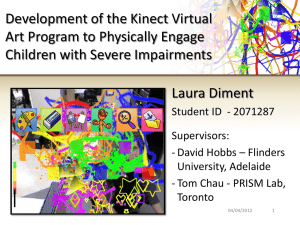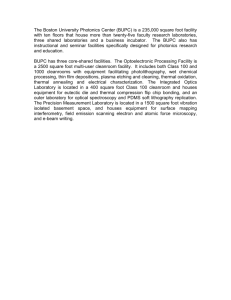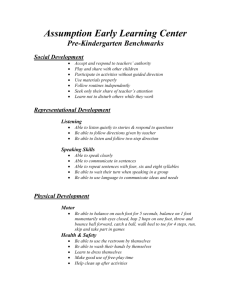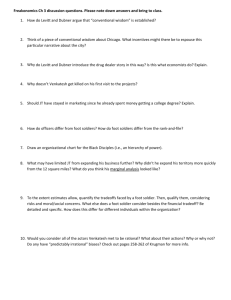Results_presentation
advertisement
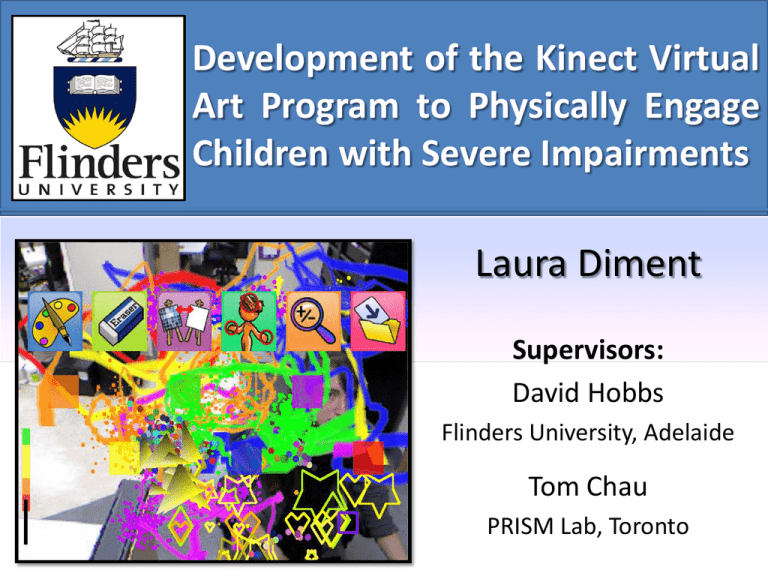
Development of the Kinect Virtual Art Program to Physically Engage Children with Severe Impairments Laura Diment Supervisors: David Hobbs Flinders University, Adelaide Tom Chau PRISM Lab, Toronto Kinect Virtual Art Program (KVAP) Hypothesis The KVAP will physically engage children with severe impairments. Outline •Benefits of art •Software development •Clinical trial •Results •Further Modifications and Uses Background • ~10% of the world's population have a disability1 Art develops2 - Communication Skills - Problem Solving Skills - Social Skills - Emotional Skills - Motor Skills - Self-Expression and Creativity • No commercial virtual art programs exist for children who cannot participate in mainstream art practices. 1Langtree, I & L (2011), Disability News, Information and Resources, Disabled World, http://www.disabled-world.com/ M A. (2011), The Importance of Art in a Child's Development, http://www.barnesandnoble.com/u/maryann-kohlimportance-of-art/379002442/ 2Kohl, Adapted Art Methods Kinect Virtual Art Program (KVAP) Benefits of a Virtual Program: •No mess •No paint accidentally consumed •Low material cost •Impairment compensation Kinect Technology •Multiple cameras and an infrared laser projector collect depth, movement and colour information. Original Design 1.5m •3 depth regions for menu access Design Issues • • • • • • Depth regions confusing Accidentally change settings Difficulty selecting menu items Difficult to activate special effects Lag No audio feedback Development • • • • • • • Microsoft SDK Beta -> full version 1.0 Single depth region Improved visuals Auditory feedback Gesture activated special effects Reduced lag Auto/manual mode Demonstration Clinical Trial • 5 Children from Trinity Gardens St Morris Unit – Level IV- V GMFCS – Level IV MACS – Non-verbal • Collaboration with Disability Studies staff and students - analyse qualitative responses • Program records quantitative data Session 1 Participant tracked limb zoom level Screen choice 1 all x2 17” 2 all x2 17” 3 all x2 17” 4 all x2 17” 5 all x2 17” Observations • Nervous/confused • Little response to visuals, some response to sound • Minimal movements and attention ~ 3min Data Collection Quantitative Qualitative •Limb position on x, y & z axes •Time •No. of button activations •No. of activate special effects •Image at 3 minute intervals •Session length Signs of: •Enjoyment •Frustration •Fatigue •Other emotions •Size of movements •Speed of movements •Percentage of screen covered Data Analysis in depth Angle Time (s) x_px y_px z_value (m) x (m) y (m) y in metres = y pixels * z distance 510 pixels/metre Calculate % of screen covered in 3 min from bmp. image: white pixels/total no. of pixels P4 Session 2 Minute 2 Right hand Left hand Head Left foot Right foot Minute 3 Minute 4 P4 Session 3 Minute 2 Right hand Left hand Head Left foot Right foot Minute 3 Minute 4 P4 Session 4 Minute 2 Right hand Left hand Head Left foot Right foot Minute 3 Minute 4 P4 Session 5 Minute 2 Right hand Left hand Head Left foot Right foot Minute 3 Minute 4 P4 Session 5 Right hand Left hand Head Left foot Right foot 2 3 4 5 Observations from sessions • Trends over the sessions: – Movement increased for 4 out of 5 participants – Enjoyment increased for 4 out of 5 participants – 2 out of 5 participants got excited in anticipation – Session length doubled – Less prompting required – More responsive to audio than visual Further Modifications and Uses • • • • Multi-user Non wheelchair users Therapy – range of motion, increasing activity Potential physiotherapist and occupational therapist analysis tool Summary • • • • • Planned and developed KVAP software Obtained ethics approval Clinical trial Positive results from analysis Children created their own printable artworks Children are engaging physically with the KVAP


